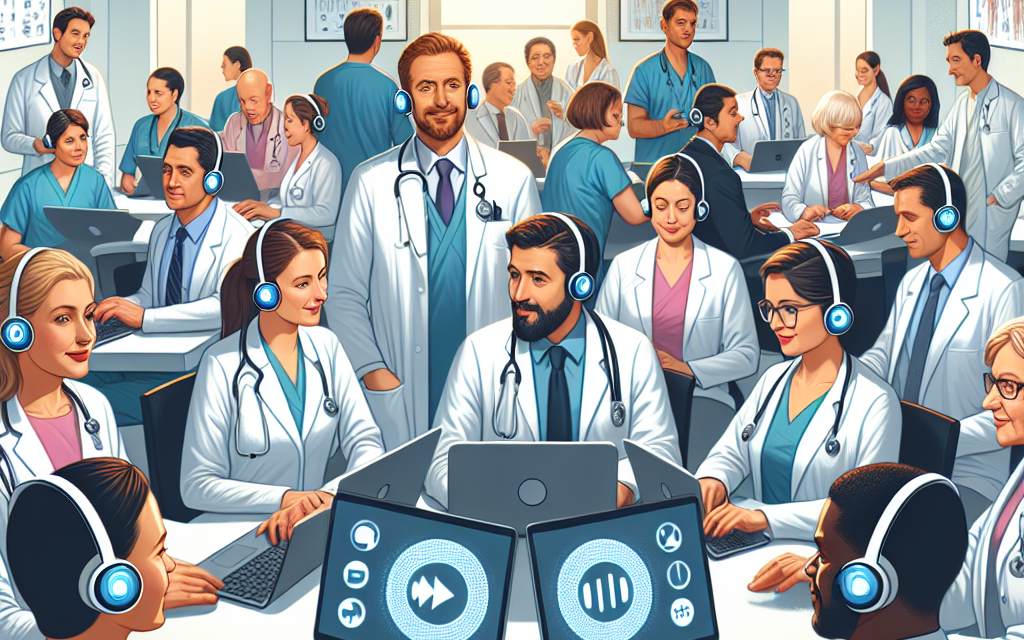Ambient Listening Technology: Enhancing Efficiency and Reducing Scribes in ENT Practices
In the rapidly evolving landscape of healthcare, technology plays a pivotal role in enhancing efficiency and improving patient care. One of the most promising advancements in this domain is ambient listening technology, which is particularly beneficial in the field of Ear, Nose, and Throat (ENT) practices. This article delves into how ambient listening technology can streamline workflows, reduce the reliance on scribes, and ultimately enhance the quality of care provided to patients.
Understanding Ambient Listening Technology
Ambient listening technology refers to systems that utilize artificial intelligence (AI) and natural language processing (NLP) to capture and transcribe conversations in real-time. This technology is designed to operate in the background, allowing healthcare providers to focus on patient interactions without the distraction of manual documentation.
In ENT practices, where detailed patient histories and clinical notes are crucial, ambient listening technology can significantly reduce the administrative burden on healthcare professionals. By automating the documentation process, providers can spend more time with patients and less time on paperwork.
The Mechanism Behind Ambient Listening Technology
At its core, ambient listening technology employs advanced algorithms to recognize speech patterns and contextualize conversations. The technology typically consists of:
- Microphones: High-quality microphones are strategically placed in the examination room to capture audio from both the provider and the patient.
- AI Algorithms: These algorithms process the audio input, distinguishing between different speakers and identifying relevant medical terminology.
- Transcription Software: The captured audio is transcribed into text, which can be integrated into electronic health records (EHRs) or used for further analysis.
This seamless integration allows for real-time documentation, reducing the need for manual entry and minimizing errors associated with traditional note-taking methods.
Benefits of Ambient Listening Technology in ENT Practices
The implementation of ambient listening technology in ENT practices offers numerous benefits, including:
- Increased Efficiency: By automating documentation, providers can allocate more time to patient care.
- Improved Accuracy: AI-driven transcription reduces the likelihood of errors that can occur with manual note-taking.
- Enhanced Patient Experience: Patients feel more engaged when providers focus on them rather than on typing notes.
- Cost Savings: Reducing the need for scribes can lead to significant cost reductions for practices.
Reducing the Need for Scribes in ENT Practices
The traditional model of employing scribes to assist healthcare providers with documentation is becoming increasingly unsustainable. Scribes are often tasked with transcribing notes during patient visits, which can lead to inefficiencies and increased costs. Ambient listening technology presents a viable alternative that can alleviate these challenges.
The Role of Scribes in Healthcare
Scribes have long been a staple in healthcare settings, particularly in specialties that require extensive documentation, such as ENT. Their primary responsibilities include:
- Documenting Patient Interactions: Scribes take detailed notes during patient visits, capturing essential information for EHRs.
- Assisting with Administrative Tasks: They may also help with scheduling, billing, and other administrative duties.
- Facilitating Communication: Scribes often serve as a bridge between providers and patients, ensuring that information is accurately conveyed.
While scribes can enhance efficiency, their presence is not without drawbacks. The reliance on scribes can lead to:
- Increased Costs: Hiring and training scribes can be expensive for practices.
- Potential for Miscommunication: Misunderstandings between providers and scribes can result in inaccurate documentation.
- Distraction from Patient Care: Providers may feel compelled to direct their attention to the scribe rather than the patient.
How Ambient Listening Technology Can Replace Scribes
Ambient listening technology offers a compelling solution to the challenges posed by traditional scribe models. By automating the documentation process, this technology can:
- Eliminate Labor Costs: Practices can save on the expenses associated with hiring and training scribes.
- Enhance Documentation Accuracy: AI-driven transcription minimizes the risk of human error.
- Improve Workflow Efficiency: Providers can focus entirely on patient care without the distraction of manual note-taking.
For instance, a study conducted at a leading ENT practice found that the implementation of ambient listening technology reduced documentation time by 50%, allowing providers to see more patients and improve overall satisfaction rates.
Case Studies: Successful Implementation of Ambient Listening Technology
Several ENT practices have successfully integrated ambient listening technology into their workflows, yielding impressive results. These case studies provide valuable insights into the practical applications and benefits of this technology.
Case Study 1: A Large ENT Practice in California
A large ENT practice in California implemented ambient listening technology to address the growing administrative burden on its providers. Prior to implementation, providers spent an average of 30 minutes per patient visit on documentation. After integrating the technology, the time spent on documentation was reduced to just 10 minutes.
This significant reduction allowed providers to increase their patient load by 20%, leading to higher revenue and improved patient satisfaction scores. Additionally, the practice reported a decrease in burnout among providers, as they could focus more on patient interactions rather than paperwork.
Case Study 2: A Rural ENT Clinic in Texas
A rural ENT clinic in Texas faced challenges related to staffing and resources. The clinic struggled to hire and retain qualified scribes, leading to inconsistent documentation practices. After adopting ambient listening technology, the clinic experienced a transformation.
The technology enabled providers to document patient visits accurately and efficiently, even in the absence of scribes. As a result, the clinic saw a 40% increase in patient throughput and a marked improvement in documentation quality. The providers reported feeling more engaged with their patients, leading to better clinical outcomes.
Case Study 3: An Academic Medical Center
An academic medical center specializing in ENT care decided to pilot ambient listening technology in one of its outpatient clinics. The goal was to assess the impact on provider efficiency and patient satisfaction.
Over a six-month period, the center found that providers using ambient listening technology spent 60% less time on documentation compared to their peers using traditional methods. Patient satisfaction scores also improved, with patients expressing appreciation for the increased attention from providers during visits.
Challenges and Considerations in Implementing Ambient Listening Technology
While the benefits of ambient listening technology are compelling, there are challenges and considerations that practices must address before implementation. Understanding these factors is crucial for successful integration.
Technical Challenges
Implementing ambient listening technology requires a robust technical infrastructure. Practices must consider:
- Hardware Requirements: High-quality microphones and audio processing equipment are essential for accurate transcription.
- Software Integration: The technology must seamlessly integrate with existing EHR systems to ensure smooth workflows.
- Data Security: Protecting patient information is paramount, necessitating compliance with regulations such as HIPAA.
Training and Adoption
Successful implementation also hinges on provider buy-in and training. Practices should focus on:
- Provider Education: Training sessions should be conducted to familiarize providers with the technology and its benefits.
- Addressing Concerns: Providers may have concerns about the accuracy of AI-driven transcription; addressing these concerns is vital for adoption.
- Feedback Mechanisms: Establishing channels for feedback can help identify areas for improvement and enhance user experience.
Cost Considerations
While ambient listening technology can lead to long-term cost savings, practices must consider initial investment costs. Factors to evaluate include:
- Upfront Costs: The initial investment in hardware and software can be significant.
- Ongoing Maintenance: Regular updates and maintenance may be required to ensure optimal performance.
- Return on Investment (ROI): Practices should assess the potential ROI based on increased efficiency and patient throughput.
The Future of Ambient Listening Technology in ENT Practices
The future of ambient listening technology in ENT practices looks promising, with ongoing advancements in AI and NLP. As technology continues to evolve, we can expect several trends to shape its future applications.
Integration with Telehealth
The rise of telehealth has transformed the way healthcare is delivered. Ambient listening technology can enhance telehealth visits by providing real-time transcription and documentation, ensuring that providers can focus on patient interactions rather than note-taking. This integration will be particularly valuable in ENT practices, where detailed assessments are crucial.
Enhanced AI Capabilities
As AI algorithms become more sophisticated, we can expect improvements in transcription accuracy and contextual understanding. Future iterations of ambient listening technology may be able to recognize specific medical terminology and nuances in patient-provider conversations, further enhancing documentation quality.
Broader Adoption Across Specialties
While ENT practices are currently leading the way in adopting ambient listening technology, other medical specialties are likely to follow suit. As the technology proves its efficacy in improving efficiency and patient care, we can anticipate broader adoption across various healthcare settings.
Conclusion
Ambient listening technology represents a significant advancement in the way healthcare providers document patient interactions. In ENT practices, this technology enhances efficiency, reduces the reliance on scribes, and ultimately improves the quality of care provided to patients. Through successful case studies and ongoing advancements, it is clear that ambient listening technology is poised to play a transformative role in the future of healthcare.
As practices consider implementing this technology, it is essential to address technical challenges, training needs, and cost considerations. By doing so, ENT practices can harness the full potential of ambient listening technology, leading to improved patient outcomes and a more sustainable healthcare model.
In summary, the integration of ambient listening technology in ENT practices not only streamlines workflows but also fosters a more patient-centered approach to care. As the healthcare landscape continues to evolve, embracing such innovations will be crucial for enhancing efficiency and delivering high-quality care.





